This pub is closed permanently. Your nearest Wetherspoon pub: The Art Picture House
This pub is named after the local mill owner and MP, whose statue stands outside the building in the Market Place. Robert Peel’s son, of the same name, was twice prime minister, first in 1834 and again in 1841.
Illustrations and text about The Robert Peel.
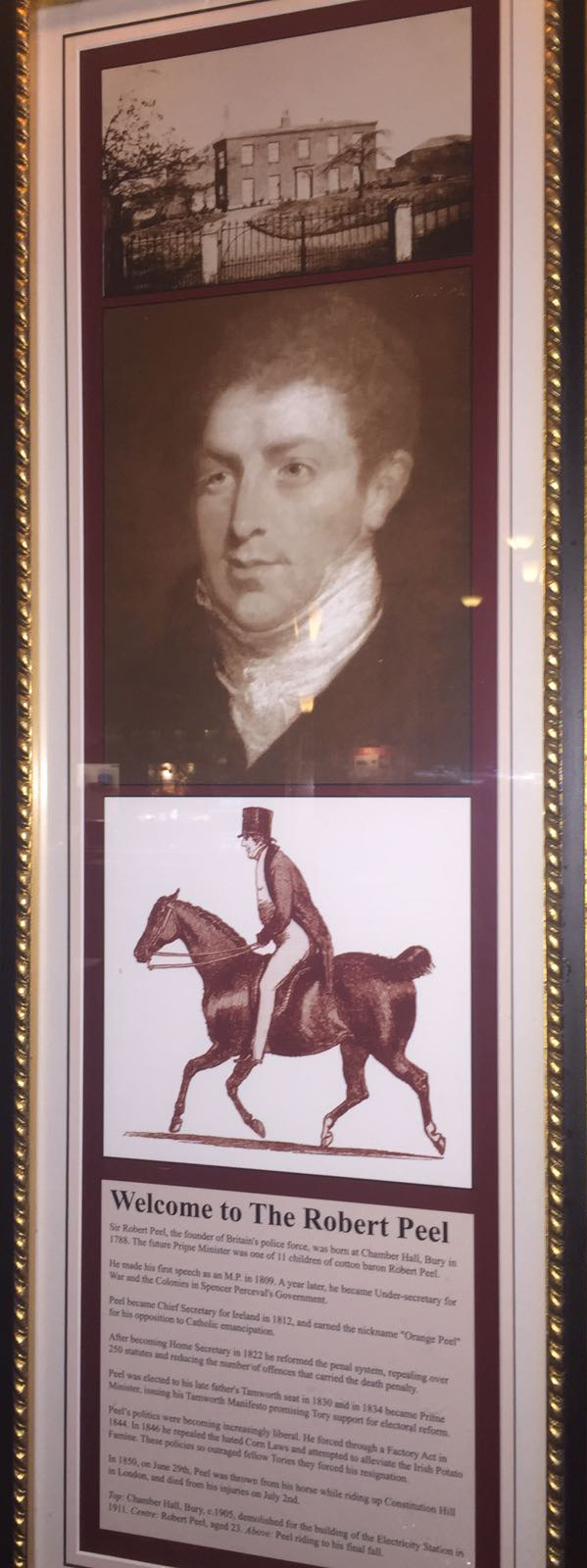
The text reads: Sir Robert Peel, the founder of Britain’s police force, was born at Chamber Hall, Bury in 1788. The future prime minister was one of 11 children of cotton baron Robert Peel.
He made his first speech as an MP in 1809. A year later, he became under-secretary for war and the colonies in Spencer Perceval’s government.
Peel became chief secretary for Ireland in 1812, and earned the nickname ‘Orange Peel’ for his opposition to Catholic emancipation.
After becoming home secretary in 1822 he reformed the penal system, repealing over 250 statues and reducing the number of offences that carried the death penalty.
Peel was elected to his late father’s Tamworth seat in 1830 and in 1834 became prime minister, issuing his Tamworth Manifesto promising Tory support for electoral reform.
Peel’s politics were becoming increasingly liberal. He forced through a Factory Act in 1844. In 1846 he repealed the hated Corn Laws and attempted to alleviate the Irish Potato Famine. These policies so outraged fellow Tories they forced his resignation.
In 1850, on June 29, Peel was thrown from his horse while riding up Constitution Hill in London, and died from his injuries on July 2.
Top: Chamber Hall, Bury, c1905, demolished for the building of the electricity station in 1911
Centre: Robert Peel, aged 23
Above: Peel riding to his final fall.
Prints and text about Bury Art Gallery and Thomas Wrigley.

The text reads: Opened in 1901, Bury Art Gallery houses one of the best collections of Victorian art on permanent display in the country – thanks to prominent local paper manufacturer Thomas Wrigley. Wrigley built up the impressive collection during the last century with the help of London art dealers Thomas Agnew and Sons.
Seventeen years after Wrigley’s death, in 1897, his children offered the collection to the people of Bury, to be housed in a purpose-built gallery created to celebrate Queen Victoria’s Diamond Jubilee.
The most precious jewel in its glittering crown is the painting, Calais Sands, by the celebrated British painter JMW Turner. The wide-ranging collection also includes four watercolours and 71 etchings by Turner and paintings by Constable and Landseer.
The gallery’s permanent collection also includes many fine paintings not donated by the Wrigley family, and examples of 20th century art, including work by Salford artist LS Lowry, famous for his matchstick figures set against Northern mill towns.
Downstairs is Bury Museum, which first opened in 1907 and received a facelift in 1990. History is brought to life by fascinating displays and working models charting life in the town from the distant past to the present day.
Top: Thomas Wrigley
Above: left, JMW Turner, right, detail of Calais Sands.
Illustrations and text about Bury Castle.
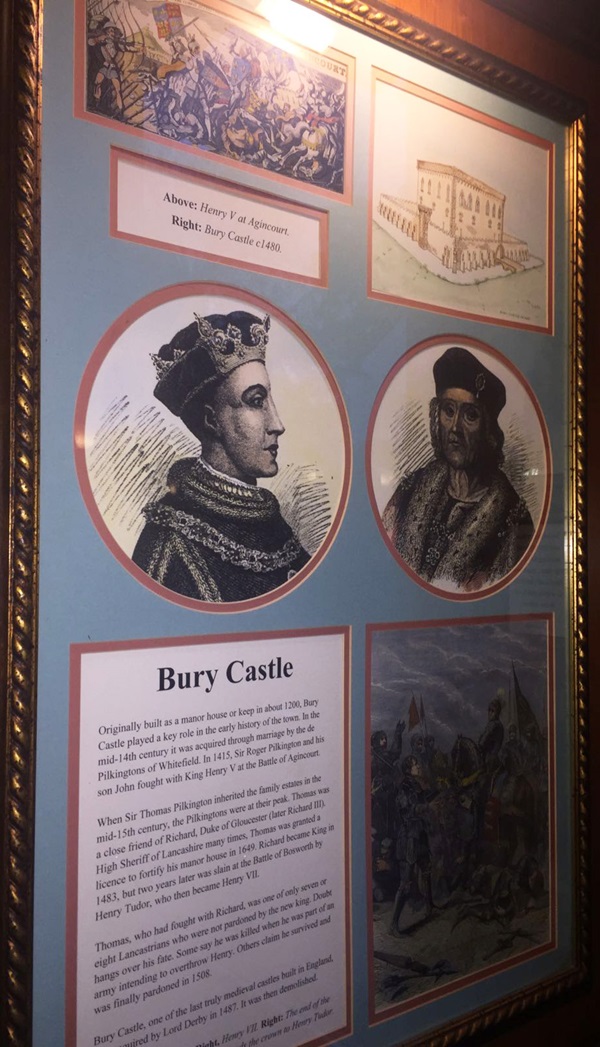
The text reads: Originally built as a manor house or keep in about 1200, Bury Castle played a key role in the early history of the town. In the mid 14th century it was acquired through marriage by the Pilkington’s of Whitefield. In 1415, Sir Roger Pilkington and his son John fought with King Henry V at the Battle of Agincourt.
When Sir Thomas Pilkington inherited the family estates in the mid 15th century, the Pilkington’s were at their peak. Thomas was a close friend of Richard, Duke of Gloucester (later Richard III). High sheriff of Lancashire many times, Thomas was granted a licence to fortify his manor house in 1649, Richard became King in 1483, but two years later was slain at the Battle of Bosworth by Henry Tudor, who then became Henry VII.
Thomas, who had fought with Richard, was one of only seven or eight Lancastrians who were not pardoned by the new King. Doubt hangs over his fate. Some say he was killed when he was part of an army intending to overthrow Henry. Others say he survived and was finally pardoned in 1508.
Bury Castle, one of the last truly medieval castles built in England, was acquired by Lord Derby in 1487. It was then demolished.
Above: left, Henry V, right, Henry VII
Right: The end of the Battle of Bosworth. Lord Stanley hands the crown to Henry Tudor.
Prints and text about the ‘Old Tech’.
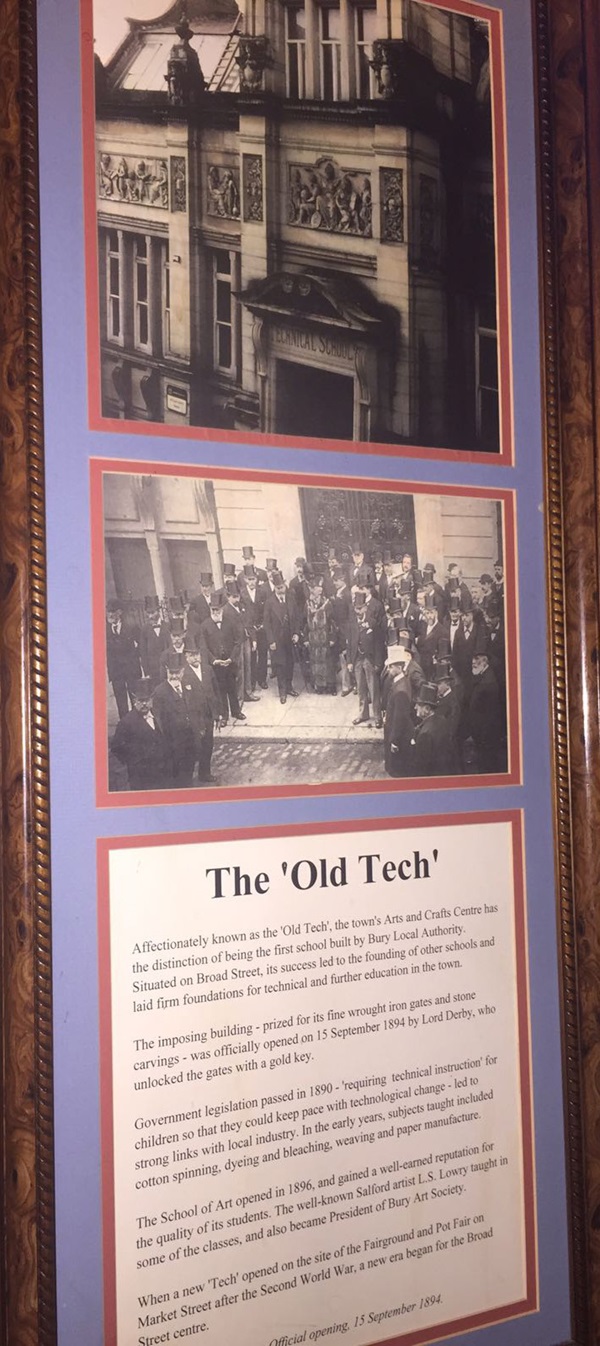
The text reads: Affectionately known as the ‘Old Tech’, the town’s Arts and Crafts Centre has the distinction of being the first school built by Bury Local Authority. Situated on Broad Street, its success led to the founding of other schools and laid firm foundations for technical and further education in the town.
The imposing building – prized for its fine wrought iron gates and stone carvings – was officially opened on 15 September 1894 by Lord Derby, who unlocked the gates with a gold key.
Government legislation passed in 1890 – ‘requiring technical instruction’ for children so that they could keep pace with technological change – led to strong links with local industry. In the early years, subjects taught included cotton spinning, dyeing and bleaching, weaving and paper manufacture.
The School of Art opened in 1896, and gained a well-earned reputation for quality of its students. The well known Salford artist LS Lowry taught in some of the classes and also became president of Bury Art Society.
When a new ‘Tech’ opened on the site of the fairground and pot fair on Market Street after the Second World War, a new era began for the Broad Street Centre.
Above: Official opening, 15 September 1894.
Prints and text about trains and trams.

The text reads: Ever since the opening of the line to Bury, in September 1846, railways have played an important role in the history of the town. Rapid expansion plans soon put Bury on the railway map.
When three local companies merged to form the East Lancashire Railway, they chose the town as their headquarters, because of the town’s industrial boom.
An imposing office block, now demolished, was built alongside the passenger station tunnelled under Bolton Street. Freight transport was catered for at a goods depot at Castlecroft, designed to handle and store raw cotton. (The East Lancashire Railway has since been restored by members of Bury Transport Museum).
Another popular form of transport introduced in Bury during Victorian times was the steam tramway. On 12 March 1883, the first tram left the Market Place, bound for Whitefield, Prestwich and Kersal. Five journeys were made that day, transporting a total of 700 passengers. Castle Street was chosen as the location for the town’s steam tram depot.
The steam trains were replaced by an electric system at the turn of the century. In 1903, the first electric tram left Moorgate for Jericho, and within two years electric tramway routes served the entire town. By 1911-12, some 15 million passengers were carried in 50 cars and conductors collected 26 tons of copper coins in fares.
Reminders of the heyday of the tram returned to the town in 1992, when the Metrolink train/tram system between Bury and Altrincham was launched.
Top: Steaming into Bury, 1955
Above: Bury Tram Depot, 1937.
Prints, illustrations and text about Richmal Crompton.
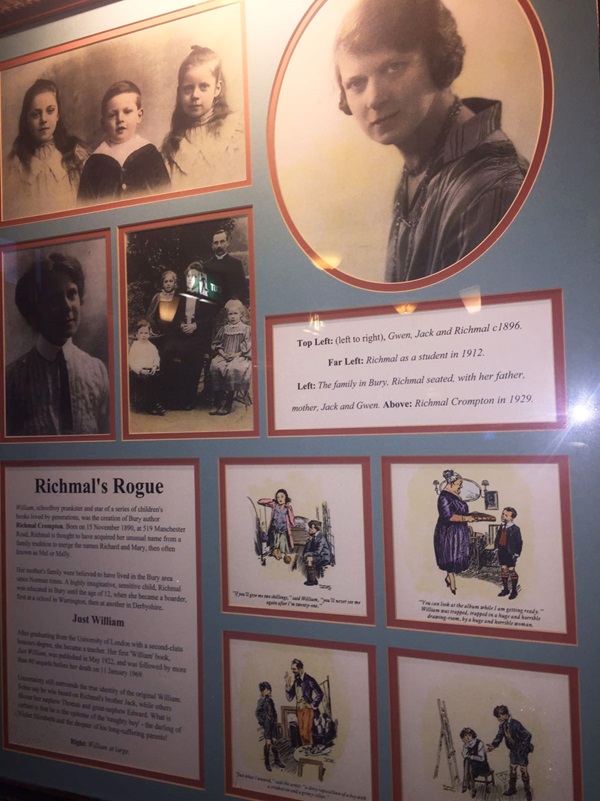
The text reads: William, schoolboy prankster and star of a series of children’s books loved by generations, was the creation of Bury author Richmal Crompton. Born on 15 November 1890, at 519 Manchester Road, Richmal is thought to have acquired her unusual name from a family tradition to merge the names Richard and Mary, then often known as Mal or Mally.
Her mother’s family were believed to have lived in the Bury area since Norman times. A highly imaginative, sensitive child, Richmal was educated in Bury until the age of 12, when she became a boarder, first at a school in Warrington, then at another in Derbyshire.
After graduating from the University of London with a second class honours degree, she became a teacher. Her first William book, Just William, was published in May 1922, and was followed by more than 40 sequels before her death on 11 January 1969.
Uncertainty still surrounds the true identity of the original William. Some say he was based on Richmal’s brother Jack, while others favour her nephew Thomas and great-nephew Edward. What is certain is that he is the epitome of the ‘naughty boy’ – the darling of Violet Elizabeth and the despair of his long suffering parents!
Right: William at large.
A print and text about Sir Charles Halle and musical heritage.
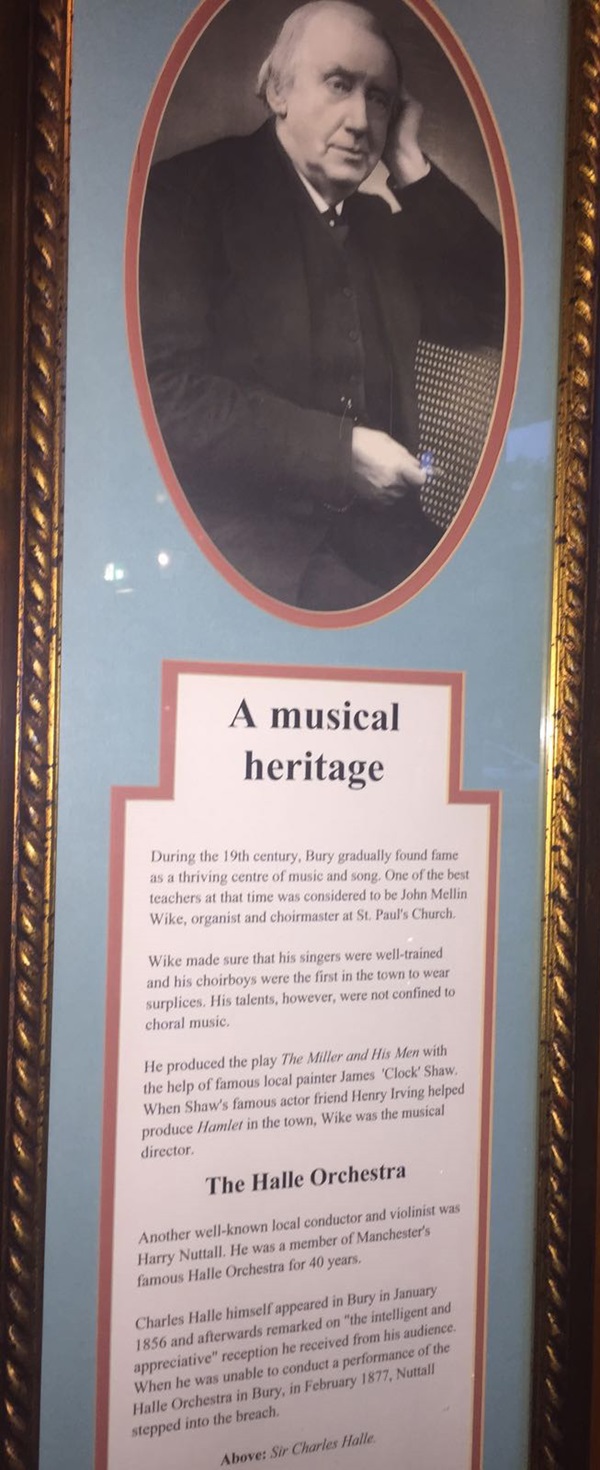
The text reads: During the 19th century, Bury gradually found fame as a thriving centre of music and song. One of the best teachers at that time was considered to be John Mellin Wike, organist and choirmaster at St Paul’s Church.
Wike made sure that his singers were well trained and his choirboys were the first in the town to wear surplices. His talents, however, were not confined to choral music.
He produced the play The Miller and His Men with the help of famous local painter James ‘Clock’ Shaw. When Shaw’s famous actor friend Henry Irving helped produce Hamlet in the town, Wike was the musical director.
Another well known local conductor and violinist was Harry Nuttall. He was a member of Manchester’s famous Halle Orchestra 40 years.
Charles Halle himself appeared in Bury in January 1856 and afterwards remarked on ‘’the intelligent and appreciative’’ reception he received from his audience. When he was unable to conduct a performance of the Halle Orchestra in Bury, in February 1877, Nuttall stepped into the breach.
Above: Sir Charles Halle.
A print and text about John Wesley.
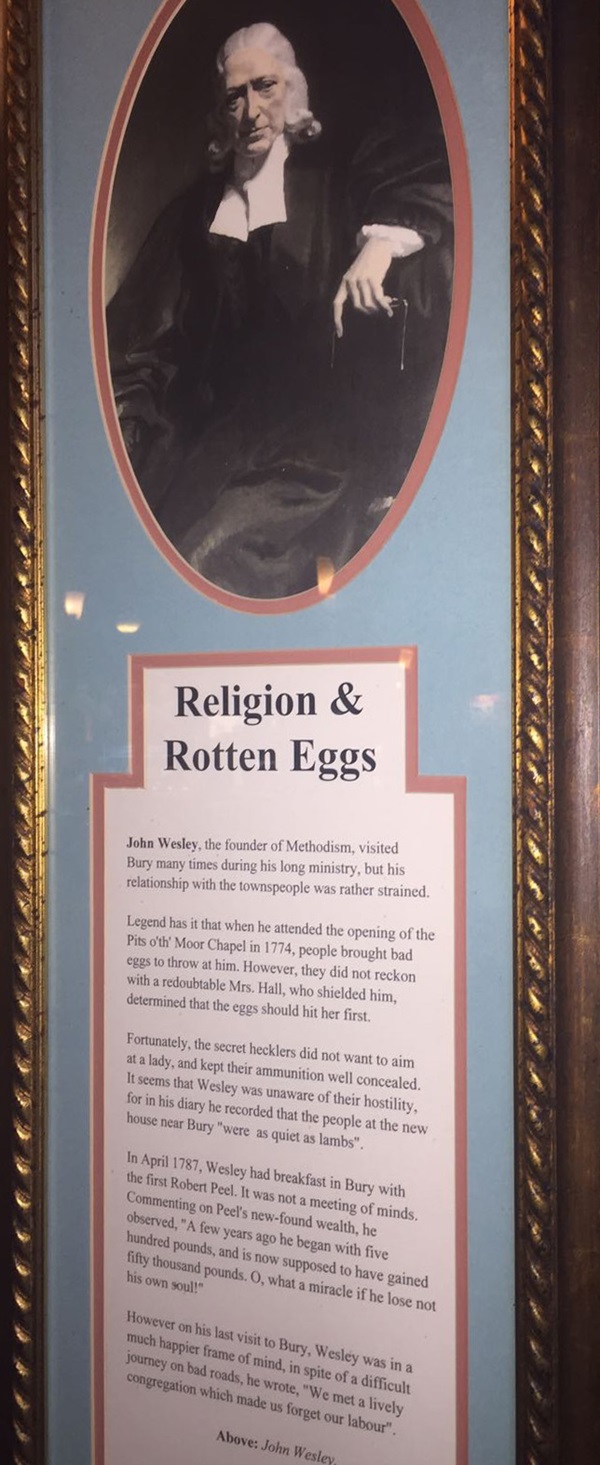
The text reads: John Wesley, the founder of Methodism, visited Bury many times during his long ministry, but his relationship with the townspeople was rather strained.
Legend has it that when he attended the opening of the Pits o’th’ Moor Chapel in 1774, people brought bad eggs to throw at him. However, they did not reckon with a redoubtable Mrs Hall, who shielded him, determined that the eggs should hit her first.
Fortunately, the secret hecklers did not want to aim at a lady, and kept their ammunition well concealed. It seems that Wesley was unaware of their hostility, for in his diary he recorded that the people at the new house near Bury ‘’were as quiet as lambs’’.
In April 1787, Wesley had breakfast in Bury with the first Robert Peel. It was not a meeting of minds, commenting on Peel’s new-found wealth, he observed. ‘’A few years ago he began with five hundred pounds, and is now supposed to have gained fifty thousand pounds, O, what a miracle if he lose not his own soul!’’
However on his last visit to Bury, Wesley was in much happier frame of mind, in spite of a difficult journey on bad roads, he wrote, ‘’We met a lively congregation which made us forget our labour’’.
A print of Moorgate, Bury, 1910.
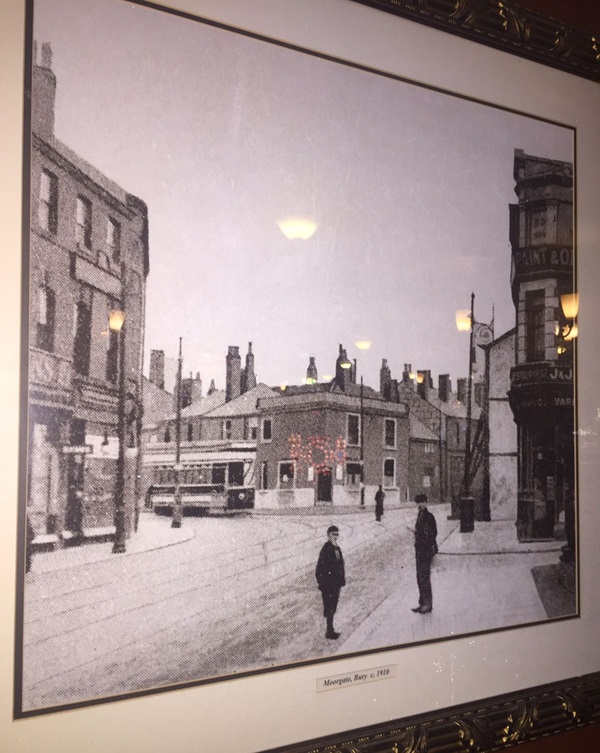
A photograph of Manchester Road, Bury, c1908.
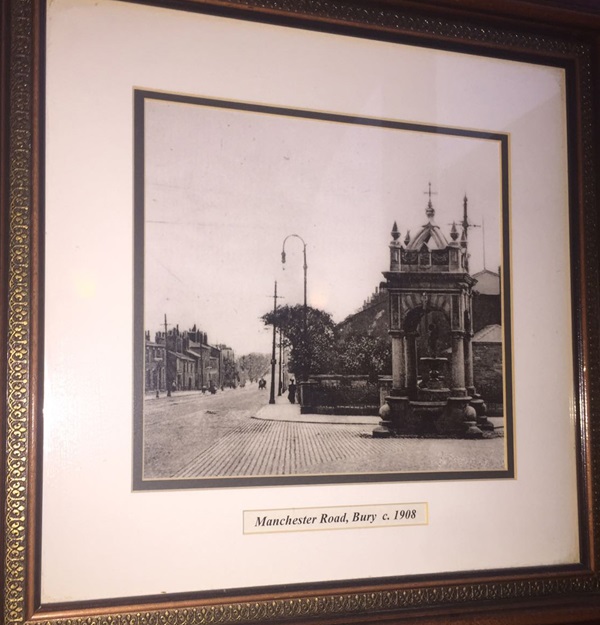
A photograph of Princess Street, Bury, c1908.

External photograph of the building – main entrance.

If you have information on the history of this pub, then we’d like you to share it with us. Please e-mail all information to: pubhistories@jdwetherspoon.co.uk